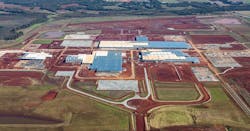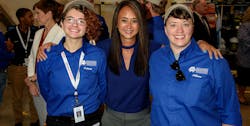Mazda Toyota Manufacturing U.S.A. has quite the fish tale to tell about its $1.6 billion joint venture assembly plant rising in Huntsville, Alabama. Last summer, concerns raised over the spring pygmy sunfish, listed as a threatened species by the U.S. Fish and Wildlife Service, briefly halted prep work at the automotive construction site and ultimately cost the automaker several million dollars.
It's a tiny thing, the spring pygmy sunfish, averaging less than an inch in length. As luck would have it, the rare fish is found in just two known locations, both in Alabama and one of which is adjacent to the new Mazda Toyota development. Several conservation groups raised alarms that construction at the auto site would harm sunfish habitat; at one point a lawsuit was threatened, but eventually the two sides in December 2018 reached an agreement in which Mazda Toyota would invest $6 million in conservation efforts related to the sunfish habitat.
"The sunfish was something we did not anticipate," says Janette Hostettler, vice president of production for Mazda Toyota Manufacturing. "But MTM is committed to the environment. We want to be good stewards."
The environmental issue is the perhaps the most highly publicized—and profound—challenge Mazda Toyota Manufacturing has faced since the two Japanese automakers announced in August 2017 their decision to collaborate in establishing the joint venture, but it certainly isn't the only challenge.
For instance, let’s talk about how to hire nearly 4,000 employees that meet your needs; or how to build a culture that takes the best of two well-established companies and emerges with something that is new, and unique, and their own; or how to address the myriad changes, conflicts and concerns that arise with any greenfield build or significant manufacturing expansion.
Mazda Toyota Manufacturing is addressing all of those challenges and more as it aims for a Spring 2021 opening, and we'll share its progress. But first, a quick look at the U.S. manufacturing construction landscape today shows just how many manufacturers are facing similar challenges. The answer is: a lot. Here's why.
The U.S. Manufacturing Real Estate Landscape
Manufacturing construction remains on a tear. Whether it be new facilities or expansions of existing sites, hard numbers continue to paint a robust picture of growth. Vacancy rates for U.S. manufacturing have dropped to 3%, well below the 10-year average of 7.1%, according to 2019 third-quarter numbers compiled by real estate services firm Cushman & Wakefield. Moreover, that vacancy rate is down from the 3.8% described in a 2018 report.
Additionally, the current 10-year average of 14.9 million square feet of new manufacturing product added annually remains significantly above the pre-recession average of 12.6 million square feet, the real estate services firm also notes, while 82.3 million square feet of U.S. manufacturing space has come online since 2010. (Not all U.S. manufacturing data is equally rosy, it must be mentioned. For example, U.S. manufacturing contracted for the fourth consecutive month in November, according to the Institute for Supply Management, while a Federal Reserve survey showed flattening performance from the manufacturing sector.)
Nevertheless, recently announced manufacturing developments are easy to find. General Motors and Isuzu in November announced a $175 million investment through their DMAX joint venture to build a diesel engine components plant in Ohio. Enviva has been okayed to build a wood pellet plant in Alabama, and earlier this year U.S. Steel announced a $1.2 billion investment in its Mon Valley Works that includes the construction of a new endless casting and rolling facility.
Over in Huntsville, Mazda Toyota Manufacturing remains on schedule for a spring 2021 launch, assures Hostettler, an 18-year veteran of Toyota who joined the joint venture team in October 2018. The sprawling complex, which sits on about 2,500 acres of land, will have 3.1 million square feet under its roof when complete. Both Toyota and Mazda will build SUVs at the site.
In a late November interview, the vice president of production shared a handful of progress statistics: metal roof deck, 100% complete; concrete floors, 40% complete; underground utility piping, 35% complete. Some exterior paint adds dashes of color but serves a functional purpose as well. The red striping, for example, indicates entrances for team members.
Of course, those numbers speak simply to the physical structure. The bigger picture is that this joint venture brings together two major companies with two company cultures and operating systems. How will this play out in Huntsville?
The Culture Challenge: One Plus One Is Greater Than Two
As any manufacturer who has seriously embraced the idea of continuous improvement knows, getting the culture piece right is more than half the battle. It's not that everything else simply falls into place when the culture is right, but it eases the way forward.
Mazda and Toyota recognize this truth as well. "Both [companies] have strengths, and both of them have issues that they've dealt with before. We don't want to repeat the issues, but it’s the strengths we want to bring together," Hostettler says. "We call it one plus one is greater than two because we want to take Mazda and Toyota and create something even better. That's our target."
Moreover, "we've got people coming from different industries (and different companies) that we want to learn from as well," Hostettler adds. "And we want to think out of the box."
Approximately 200 team members have been hired to date, primarily management staff but also a mix of others. Among those others are "dojos," or the team leaders who will train most of the Mazda Toyota team members, thus placing them on the front lines of building culture. The first wave of about 25 soon-to-be trainers were set to return to the United States in December from a three-month stint in Japan, where they were learning about the joint venture's parent companies as well as fundamental skills of working on a production floor. Most importantly, the dojos learn not only what to train, but how to train.
And how to train means more than showing new hires how to place a bolt or sand a steel panel, Hostettler explains. "It means, if [the trainee] is not doing it correctly, how do you tell them so that you are not coming down on them," she says. "How do you do it in a positive way."
There's a Japanese word for it—mendomi—which loosely translates to care and concern. The term is emblematic of the type of culture Mazda Toyota aims to create at the Huntsville assembly site.
The Challenge of the Big Hire
One element every new manufacturing facility requires is people to help make it go. While Mazda Toyota has welcomed aboard about 200 team members, it will require many more if the estimated need for 4,000 employees holds up. Mass hiring is slated to begin in January 2020.
"It's quite a challenge, and with the ramp-up curve we have, no doubt it's going to be difficult. But I feel very confident," Hostettler says. "We've got a great human resource team here, and we're partnering with some outside resources. I feel like we have a very good plan."
It's not just numbers that the new site seeks, however. Mazda Toyota says it is being very deliberate in its efforts to attract the right workforce. Among the companies helping to make that happen is PSI Services, a consulting and assessments solution firm. In collaboration with Mazda Toyota, PSI Services designed both an online assessment and hands-on simulation tool to help the joint venture determine which job applicants have the best chance for success at the Huntsville plant.
The hands-on simulation, located in Mazda Toyota's assessment center, allows potential team members to get a realistic feel for what the physical work at the Huntsville plant would entail. Seven physical vehicles are at the site, each with four stations.
"One of the biggest reasons we hear for turnover is the person just didn't feel like they knew what (the work) was going to be like," says PSI Services' Steven Jarrett, director of the manufacturing center of excellence. Hands-on simulations help unwrap that mystery, particularly at a site like Huntsville where no plant yet exists, he says.
The Challenge of Change
Change is inevitable in a project this size, and the Mazda Toyota partnership has had its share to address. In addition to the unexpected appearance of the spring pygmy sunfish was the switch by Toyota to a brand-new vehicle model to assemble. When the joint venture launched, Toyota had planned to build the Corolla in the new assembly plant. In July 2019, those plans changed, and now the automaker says it will assemble a new SUV.
"We had to make some quick adjustments, some quick decisions" with the vehicle change, says Hostettler. For example, from a process standpoint comes the need to incorporate a back hatch instead of a trunk lid.
Nevertheless, while the change was significant, the impact on the launch date was not. Hostettler gives a nod to robust change point management systems in mitigating the impact. "It makes us a very flexible and agile company," she says.
Moreover, the Mazda Toyota joint venture also employs the "obeya room" concept, a term that may be familiar to companies engaged in lean manufacturing. The obeya room gives the team at the Huntsville site the ability to visualize each shop within the plant, both on the administrative and production sides. It also gives the joint venture added ability to react to change.
"We preach a culture here that we want to surface all problems quickly so that we can make decisions quickly. And part of that is visualization," Hostettler says. "It's part of our culture."
Still To Come
Initially, most of the shops (paint and assembly, for example) that make up manufacturing site will host two lines, one for Toyota and one for Mazda. Longer term, Hostettler says, the aim is to build a bridge to be able to make either model on either line. Even longer term, the goal is to be fully integrated and ultimately create a vehicle together.
The near future, however, means getting the plant up and running, and as much as you plan for every eventuality, stuff happens. But there is even a plan for that.
"We are all process driven, and whenever that process has a change point or kink in it, you have to go back. We call that PDCA (Plan, Do, Check, Act)," Hostettler says. "I imagine the next few years are going to be a lot of PDCA."
About the Author
Jill Jusko
Bio: Jill Jusko is executive editor for IndustryWeek. She has been writing about manufacturing operations leadership for more than 20 years. Her coverage spotlights companies that are in pursuit of world-class results in quality, productivity, cost and other benchmarks by implementing the latest continuous improvement and lean/Six-Sigma strategies. Jill also coordinates IndustryWeek’s Best Plants Awards Program, which annually salutes the leading manufacturing facilities in North America.
Have a story idea? Send it to [email protected].


